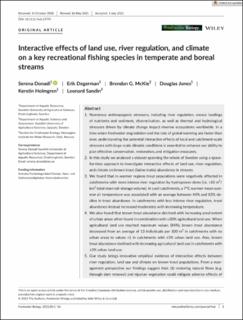| dc.description.abstract | Numerous anthropogenic stressors, including river regulation, excess loadings of nutrients and sediment, channelisation, as well as thermal and hydrological stressors driven by climate change impact riverine ecosystems worldwide. In a time when freshwater degradation and the rate of global warming are faster than ever, understanding the potential interactive effects of local and catchment-scale stressors with large-scale climatic conditions is essential to enhance our ability to plan effective conservation, restoration, and mitigation measures. In this study we analysed a dataset spanning the whole of Sweden using a space-for-time approach to investigate interactive effects of land use, river regulation, and climate on brown trout (Salmo trutta) abundance in streams. We found that in warmer regions trout populations were negatively affected in catchments with more intense river regulation by hydropower dams (i.e. ≥10 m3/km2 total reservoir storage volume). In such catchments, a 7°C warmer mean summer air temperature was associated with an average between 44% and 83% decline in trout abundance. In catchments with less intense river regulation, trout abundance instead increased moderately with increasing temperature. We also found that brown trout abundance declined with increasing areal extent of urban areas when found in combination with ≥20% agricultural land use. When agricultural land use reached maximum values (84%), brown trout abundance decreased from an average of 13 individuals per 100 m2 in catchments with no urban areas to values ≤1 in catchments with ≥5% urban land use. Also, brown trout abundance declined with increasing agricultural land use in catchments with ≥3% urban land use. Our study brings innovative empirical evidence of interactive effects between river regulation, land use and climate on brown trout populations. From a management perspective our findings suggest that: (1) restoring natural flows (e.g. through dam removal) and riparian vegetation could mitigate adverse effects of climate change; and (2) restoration measures that minimise the effects of agriculture and urban land use (e.g. reduction of nutrient levels and restored riparian buffer zones) could help rehabilitate brown trout in catchments with high anthropogenic land use change. However, given the large observed variation between streams, we advise for bespoke management actions stemming from sound knowledge of local habitat conditions and target populations, whenever possible, using an ecosystem management-based approach. | en_US |

